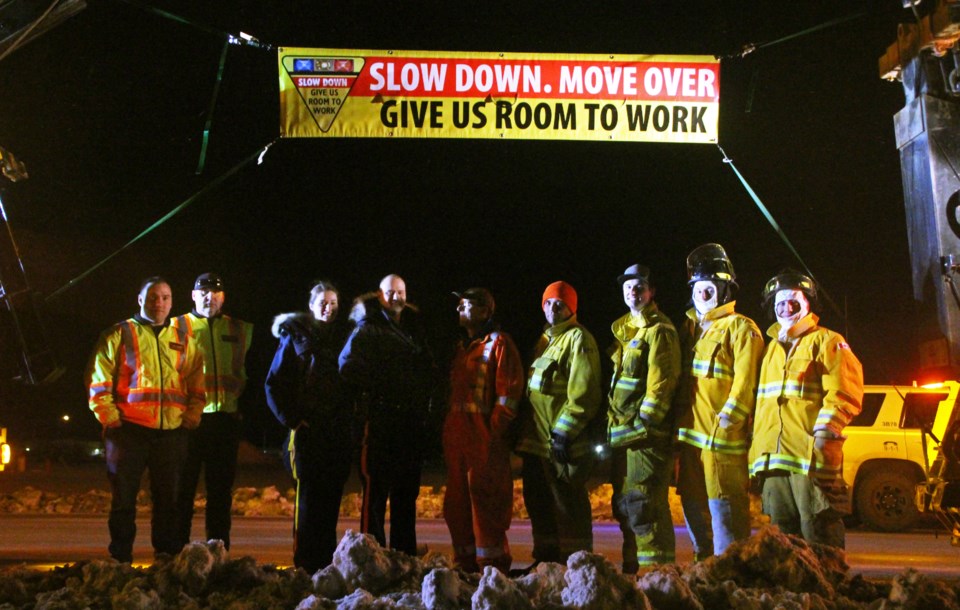"Slow down, move over, give us room to work."
That was the message local tow truck drivers and emergency response crews were trying to push last week.
Gathered on the Hwy. 28 service road at the west end of town on March 7, members of the Bonnyville RCMP, Bonnyville Regional Fire Authority (BRFA), and towing companies had their lights flashing for one hour to remind drivers they're required to slow down and move over when passing emergency vehicles. Not only is it a courtesy – it's the law.
"People have to remember that the operators that are employed in the towing industry, they're just trying to make it home to their families at the end of the day. All of these guys are fathers, sons, husbands, we all have families and they're counting on us to come home at night and provide a livelihood for our families," said JF Gagnon of Big Time Towing.
As president of the provincial towing association, Gagnon helped kick-start rallies across Alberta after being approached by the Saskatchewan organization. In honour of a tow truck driver who was killed doing his job, and to try and prevent future tragedies, the group is attempting to turn the slow down, move over awareness campaign into a nation-wide annual occurrence.
"Last year, on March 7, there was a tow truck operator that got killed on the side of Hwy. 22 in Saskatchewan. The Roadside Responders Association of Saskatchewan held this same type of rally five days later on 11 different highway locations with that same goal to promote slow down, move over. It's to remind drivers they have to slow down to 60 km/h when they're passing tow trucks or emergency vehicles," Gagnon explained.
Fellow tow truck driver Chris Godfrey, from Collision Towing, showed his support for the initiative, stressing it's an issue he's seen time and time again.
"It's huge. There's many times I've almost been hit. Our Cold Lake driver, his truck has been hit by a passerby when he was trying to do his job."
In Alberta, motorists are required to reduce their speed to 60 km/h, or less if the posted speed is lower, when passing emergency vehicles and tow trucks. Failing to do so could result in fines that are double the usual ticketed amount for speeding.
Despite a law being in place to protect workers when they're on the side of the road, drivers' disregard of the rule is putting emergency crews in danger on a regular basis.
"This is a constant problem across North America. When people see tow trucks or emergency vehicles on the highway, they have to slow down to give us room to work on the highways," said BRFA chief Brian McEvoy. "One of the most dangerous places that we work is on the highways or the streets. There's more injuries to emergency responders in those situations than there are fighting fires or anything else we do."
McEvoy noted that it has gotten worse in recent years with distracted driving becoming more prevalent.
"The more things going on in vehicles – everything from cell phones, GPS, interactive screen systems in vehicles – people are paying less attention to what's going on, on the highways and streets. We have seen an increase in near misses over the last five to six years."
A lack of safety and security on the roadways for emergency crews and tow truck drivers has meant they've had to take extra measures to ensure they can get the job done.
"We're having to commit and dedicate more and more emergency responders simply to traffic control and scene security," said McEvoy.
Gagnon agreed, "If we're out on the road and don't feel safe, and people don't slow down and move over to give us the room to do our jobs, at the end of the day we're going to have to make the room for ourselves. That's when we have to bring extra units on scene to install warning signs, do traffic control. Extra manpower and extra vehicles on scene means extra cost that will be passed onto the motorist at the end of the day."
While the slow down, move over rally was just one day, their efforts to make the highways safer don't stop there. The provincial towing association has been working with AMA and Alberta Transportation in an attempt to update some of the laws regarding tow trucks and emergency vehicles.
Currently in Alberta, the requirement to slow down only applies to the lane directly next to where the emergency crews are stopped. Instead, Gagnon explained they would like to see that changed to every lane of traffic that's travelling in the same direction.
"That would mean on a four-lane highway, for example, all eastbound traffic would have to slow down regardless of what lane they were in."
They're also working to change the legislation to allow tow trucks to be outfitted with blue and white flashing lights.
"It's to differentiate us from the rest of the vehicles that currently are outfitted with amber lights," said Gagnon. "People are seeing amber beacons everywhere that they're going down the highway and not realizing until the last minute that, "oh, that's a tow truck.'"
In the meantime, Godfrey said the message is simple:
"Slow down, move over, give the emergency workers room to work. We're all here trying to help, we're not trying to make people mad or cause traffic jams. We're just out there doing our jobs."



